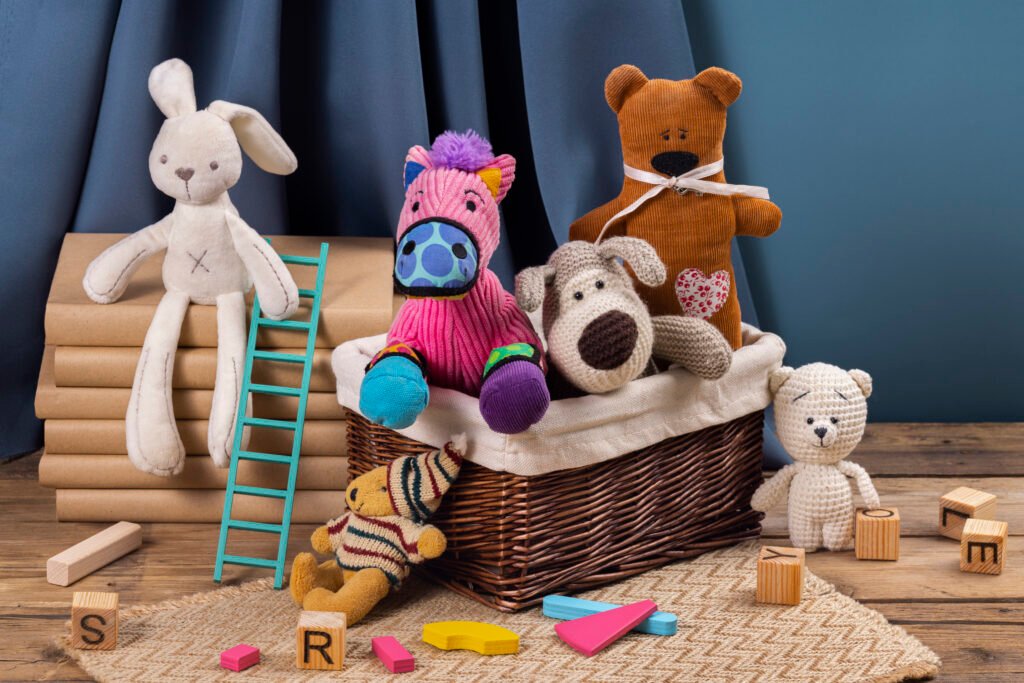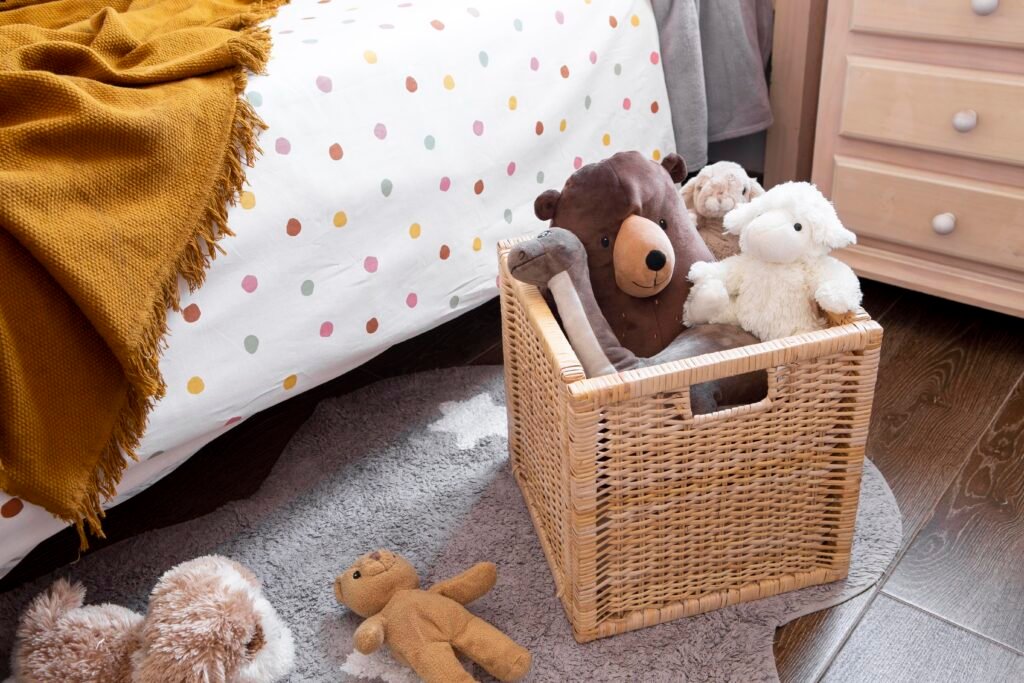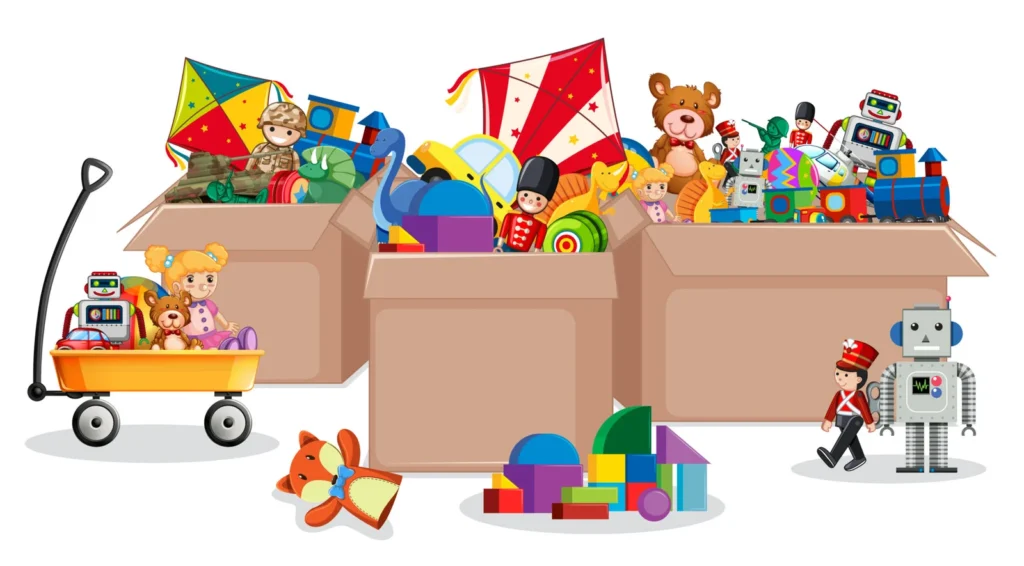Keeping your child’s toys organized can feel like an endless battle, but the benefits of a well-organized toy area are numerous. Not only does it create a cleaner and more inviting space, but it also promotes creativity, reduces clutter, and teaches valuable organization skills to children. In this blog post, we’ll explore practical tips and strategies to help you effectively organize your kids’ toys.
Assessing and Sorting

The first step in organizing your kids’ toys is to take inventory and sort them into categories. Set aside some time to go through each toy, assessing its condition and relevance. Consider categorizing toys by type, such as dolls, building blocks, or puzzles, to make organization easier.
As you sort through the toys, involve your children in the process. This not only teaches them valuable decision-making skills but also gives them a sense of ownership over their toys. Encourage them to help decide which toys to keep, donate, or discard based on their interests and preferences.
Decluttering
Once you’ve sorted the toys into categories, it’s time to declutter. Take a critical look at the toys your children have outgrown or no longer play with and consider donating or discarding them. While it can be challenging to let go of toys, especially sentimental ones, remember that decluttering creates space for new experiences and encourages creativity.
When decluttering, involve your children in the decision-making process. Help them understand the importance of letting go of excess toys and the joy of giving to others who may need them more. Make decluttering a positive experience by focusing on the benefits of a tidy and organized toy area.
Storage Solutions
Choosing the right storage solutions is essential for keeping your kids’ toys organized and accessible. Consider investing in bins, baskets, shelves, and organizers to help keep toys neatly stored and easily accessible. Choose storage containers that are durable, easy to clean, and appropriate for your child’s age and abilities.
Create designated spaces for different toy categories to make it easier for children to find and put away their toys. Label storage containers with pictures or words to help children identify where each toy belongs. Utilize clear bins or transparent storage solutions to make it easier to see what’s inside.
Labeling and Accessibility
Labeling storage containers is key to maintaining an organized toy area. Use clear and simple labels that are easy for children to read and understand. Include pictures or illustrations to help young children who may not be able to read yet. By labeling storage containers, you empower children to take responsibility for putting away their toys independently.
Ensure that toys are accessible to children of all ages and abilities. Store frequently used toys within reach and heavier or less frequently used items on higher shelves. Consider rotating toys periodically to keep playtime fresh and exciting while minimizing clutter.
Setting Up Play Zones
Designating specific areas for different types of play can help organize your kids’ toys and create a more functional play space. Create separate play zones for quiet activities like reading or drawing and active play like building or pretend play. Incorporate cozy corners with bean bags or cushions for quiet activities and designate larger areas for active play.
Multipurpose furniture can also help maximize space and functionality in your kids’ play area. Look for storage ottomans, benches, or tables with built-in storage to keep toys neatly concealed when not in use. By setting up distinct play zones, you create a more organized and enjoyable play environment for your children.
Maintenance and Routine
Establishing a regular cleanup routine is essential for maintaining an organized toy area. Encourage your children to participate in daily or weekly cleanup sessions to keep their toys tidy and organized. Make cleanup fun by turning it into a game or setting a timer to see how quickly they can tidy up.
Teach your children the importance of taking care of their toys and putting them away after playtime. By instilling good organization habits early on, you help set them up for success in the future. Regularly reassess and reorganize toys as needed to accommodate changes in your child’s interests and preferences.
Creative Ideas and DIY Solutions

In addition to traditional storage solutions, there are plenty of creative and budget-friendly ways to organize your kids’ toys. Repurposing household items for toy storage is a great way to save money and reduce waste. Consider using empty baskets, shoe organizers, or hanging organizers to corral toys and keep them off the floor.
DIY projects are another fun and creative way to customize storage solutions for your kids’ toys. You can repurpose old crates or pallets to create shelves or storage bins, or use colorful bins and crates to add a pop of color to your child’s play area. Get creative with paint, stickers, or stencils to personalize storage containers and make them more appealing to children.
Incorporating creative displays or wall storage options can also help save space and keep toys organized. Hang baskets or shelves on the wall to store toys vertically and free up floor space. Use wall-mounted pegboards or hooks to hang dress-up clothes, art supplies, or other items that tend to clutter up the floor.
Involving Children
Finally, involving your children in the organization process is essential for teaching them valuable organization skills and fostering independence. Encourage your children to take ownership of their toy area by allowing them to help choose storage solutions, label containers, and organize their toys.
Use playtime as an opportunity to teach organization skills by incorporating games and activities that involve sorting, categorizing, and cleaning up toys. Model good organization habits by keeping your own spaces tidy and organized, and praise your children for their efforts in keeping their toy area neat and organized.
Celebrate and reinforce organization efforts by creating a reward system or offering praise and encouragement when your children demonstrate good organization skills. By involving your children in the organization process and making it a positive and collaborative experience, you help instill lifelong habits that will serve them well in the future.
Conclusion
Organizing your kids’ toys can feel like a daunting task, but with the right strategies and approach, it can be a rewarding and enjoyable experience for both you and your children. By assessing and sorting toys, decluttering, choosing appropriate storage solutions, and involving your children in the process, you can create a functional and organized toy area that promotes creativity, reduces clutter, and teaches valuable organization skills.
Stay tuned for more tips and ideas to help you create a tidy and inviting play space for your children. With a little creativity and effort, you can transform your kids’ toy area into a organized and enjoyable space where they can play, learn, and grow.
FAQs (Frequently Asked Questions) – How to Organize Kids’ Toys
1. Why is toy organization important?
- Toy organization is essential for several reasons. It helps create a safe and clutter-free environment for children to play in, reduces stress and frustration for parents, and teaches children valuable life skills such as responsibility and organization.
2. How do I know which toys to keep and which to get rid of?
- When decluttering toys, consider factors such as how often the toy is played with, its condition, and its age appropriateness. Keep toys that are favorites and regularly played with, and consider donating or disposing of toys that are broken, unused, or no longer age-appropriate.
3. What are the best storage solutions for organizing kids’ toys?
- The best storage solutions for organizing kids’ toys depend on factors such as the size and quantity of toys, available space, and personal preferences. Bins, baskets, shelves, and toy chests are popular options for storing toys. Choose containers that are durable, accessible, and appropriately sized for your toy collection.
4. How can I encourage my child to participate in cleanup and organization?
- Encouraging children to participate in cleanup and organization can be made fun and engaging. Turn cleanup into a game or challenge, offer praise and rewards for participation, and lead by example by demonstrating good organization habits yourself. Make cleanup a routine part of daily activities to reinforce the importance of tidiness.
5. What are some tips for maintaining organization over time?
- To maintain organization over time, implement regular toy rotations to keep things fresh and exciting for your children. Store seasonal or less frequently used toys out of sight to reduce clutter. Teach children responsibility by encouraging proper toy care and cleanup habits, and reinforce the importance of organization and tidiness as essential life skills.
6. How can I make the most of limited space when organizing kids’ toys?
- Maximizing space efficiency is key when organizing kids’ toys in smaller living spaces. Utilize vertical storage solutions such as shelves or wall-mounted organizers to free up floor space. Make use of under-bed storage or over-door organizers to take advantage of unused space. Incorporate multifunctional furniture with built-in storage compartments or opt for modular or collapsible furniture for flexibility.









